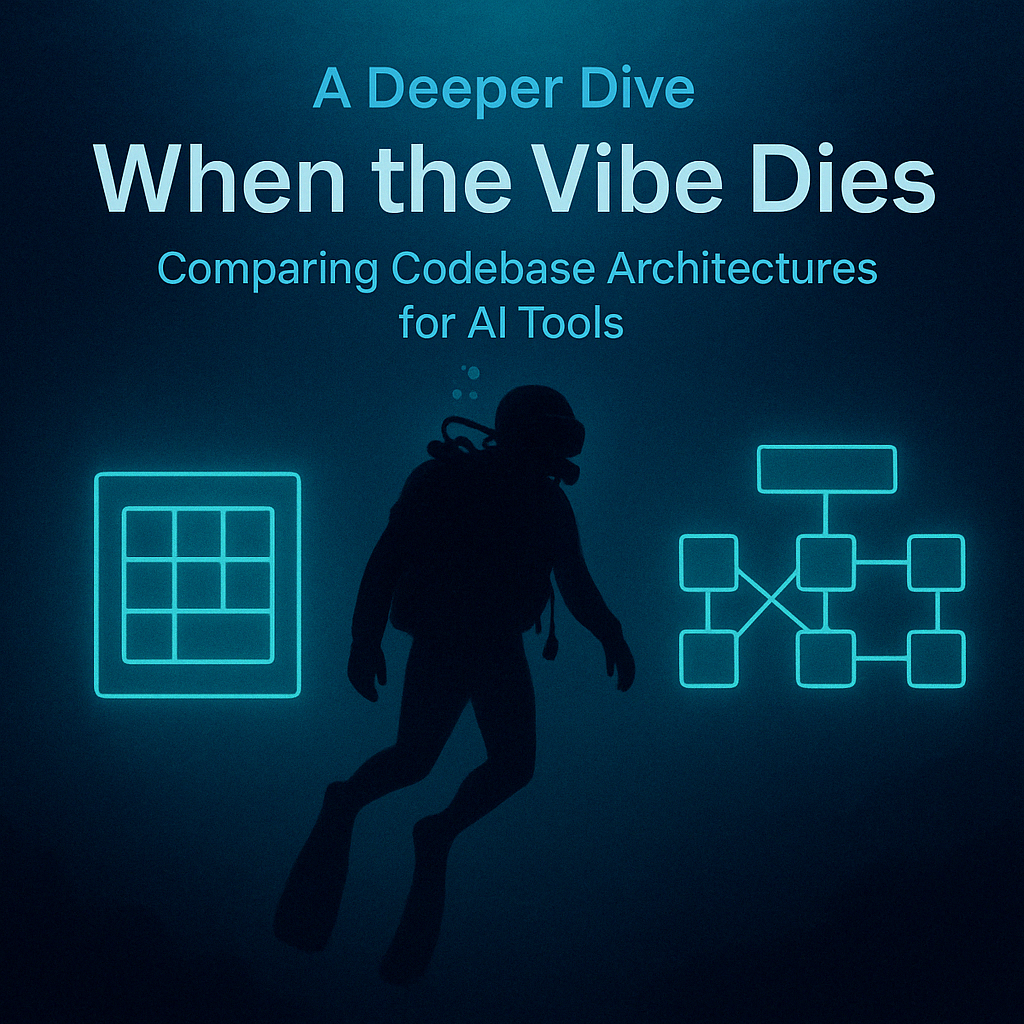April 18, 2025
Comparing Codebase Architectures for AI Tools
As AI coding tools become more prevalent in software development, choosing the right architecture can significantly impact both development efficiency and AI collaboration. This article explores three prominent architectural approaches and their implications for AI-assisted development.
Let’s examine these architectures in detail. We’ll analyze how each one uniquely positions itself to handle AI-assisted development workflows. We’ll also explore what trade-offs developers need to consider when making architectural decisions. This is a continuation of this vibe article.

Atomic Composable Architecture: Nature-Inspired but Complex
The Atomic Composable Architecture draws inspiration from natural systems, organizing code into a hierarchy of increasingly complex components:
Strengths
- Exceptional Reusability: Built on modular, reusable components (atoms, molecules, organisms), enabling high code reuse
- Natural Conceptual Model: The hierarchical structure mirrors natural systems, making it intuitive for both humans and AI tools
- Testability: Fine-grained atomic components enable isolated testing, building confidence in the system’s reliability
- Scalability: The architecture scales well by continuously adding new atoms, molecules, and organisms as needed
Challenges
- Modification Chain Problem: Changes to lower-level atoms require modifications across all dependent higher-level components, creating ripple effects throughout the system
- Discipline Requirements: Maintaining proper composition hierarchies demands rigorous developer discipline
- Context Bloat for AI Tools: When modifications span multiple levels, AI tools require more context to understand and implement changes consistently
This architecture works well for AI tools when working on isolated components. It can become unwieldy when changes cross compositional boundaries.
Vertical Slice Architecture: Optimized for AI Understanding
Vertical Slice Architecture has emerged as particularly AI-friendly, organizing code by feature rather than technical layers.
Strengths
- Simplified Context Management: All code relevant to a specific feature is contained within a single directory, making it easier for AI tools to grasp the complete picture
- Efficient Context Priming: AI tools can be quickly primed with all relevant context by pointing to a single feature directory
- Token Efficiency: By focusing only on relevant feature slices, this architecture reduces token consumption for AI tools
- Clear Feature Boundaries: Feature-based organization provides natural conceptual boundaries for AI to understand
The Deliberate Trade-off
The primary disadvantage—code duplication—is actually a conscious design choice. By avoiding shared utilities across features, each slice maintains isolation. This prevents changes in one area from affecting others. While this contradicts traditional DRY (Don’t Repeat Yourself) principles, it optimizes for AI understanding and context management.
For AI agents, this architecture allows each agent to reside within its own slice. Each slice contains all necessary code and configurations. This facilitates effective versioning and management.
Pipeline Architecture: Specialized but Limited
Pipeline Architecture organizes processing steps sequentially, similar to an assembly line.
Strengths
- Natural Flow: The sequential process flow provides clarity that AI tools can easily comprehend
- Type Clarity: Well-defined input/output types between steps help AI tools understand data transformations
- Modular Steps: Individual pipeline steps can be easily reordered or modified
- Parallel Processing Potential: Independent steps can often be executed concurrently
Limitations
- Domain Specificity: Pipeline architecture is suitable for sequential processes like data engineering workflows, limiting its general applicability
- Inappropriate for Most Applications: Applying this architecture to typical web applications would introduce unnecessary complexity
- State Management Challenges: Tracking state as data flows through multiple processing steps can become complex
Pipeline Architecture remains valuable in specific domains like data engineering and machine learning operations. AI tools focusing on these domains benefit from its structured nature and clear data flow.
We have used this at scale. It fits well with AI code assist.
Conclusion: Context Is King
The optimal architecture for AI-assisted development prioritizes context management above all else. Vertical Slice Architecture currently leads in AI compatibility. Each approach offers unique advantages depending on project requirements.
As AI tools evolve, their ability to handle complex architectures will likely improve. For now, deliberately designing for “AI readability” alongside human readability represents a fundamental shift in software architecture principles. This shift promises efficiency gains for development teams embracing AI collaboration.
About the Author
Rick Hightower is a software architecture expert specializing in AI-assisted development practices. With extensive experience in implementing various architectural patterns at scale, Rick focuses on optimizing codebases for both human and AI collaboration. He regularly writes about emerging trends in software development and the intersection of artificial intelligence with traditional programming paradigms.
TweetApache Spark Training
Kafka Tutorial
Akka Consulting
Cassandra Training
AWS Cassandra Database Support
Kafka Support Pricing
Cassandra Database Support Pricing
Non-stop Cassandra
Watchdog
Advantages of using Cloudurable™
Cassandra Consulting
Cloudurable™| Guide to AWS Cassandra Deploy
Cloudurable™| AWS Cassandra Guidelines and Notes
Free guide to deploying Cassandra on AWS
Kafka Training
Kafka Consulting
DynamoDB Training
DynamoDB Consulting
Kinesis Training
Kinesis Consulting
Kafka Tutorial PDF
Kubernetes Security Training
Redis Consulting
Redis Training
ElasticSearch / ELK Consulting
ElasticSearch Training
InfluxDB/TICK Training TICK Consulting

